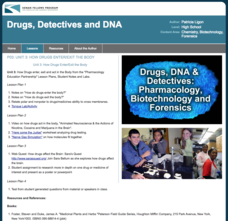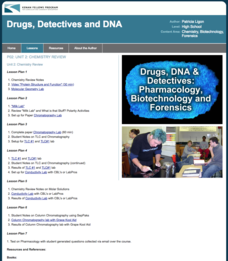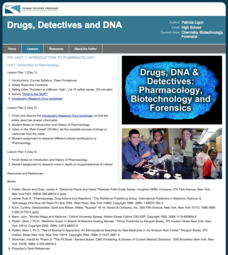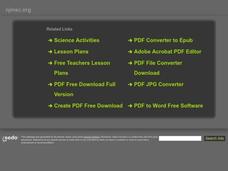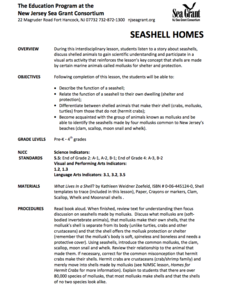Kenan Fellows
Unit 3: How Drugs Enter/Exit the Body
The third of a four-part series on Pharmacology teaches scholars how drugs enter and exit the body, how they act inside the body, how they affect the brain, and more. Over the course of the unit, groups complete two labs and one...
Kenan Fellows
Unit 2: Chemistry Review
What exactly goes into the medications people take every day? Scholars learn about the chemistry of medications in the second of a four-part series on Pharmacology. Over the course of two weeks, class members complete seven experiments,...
Kenan Fellows
Unit 1: Introduction to Pharmacology
Learn about the study of medications, including those found in nature and those made synthetically. The first of four lessons in a series on pharmacology includes lectures, hands-on experiments, research, and more.
Curated OER
Shapes and Tools
Young learners view different shapes drawn by the teacher on the board. The teacher identifies each shape by name and discusses the importance of knowing the difference between shapes when building something. The pupils complete the...
Houghton Mifflin Harcourt
Use a Graph: Measure Fish
Something's fishy here! Use the bar graph provided to determine the length of each fish shown. Small cartoon fish make this an engaging instructional activity for young learners. There are six questions provided.
Houghton Mifflin Harcourt
Zombie Ants
One of the creepiest and coolest natural occurrences is a great forum for data analysis and discussion! Explore the phenomenon of zombie ants, or ants infected with the Cordyceps fungus, with a series of activities and experiments....
Curated OER
Classification and Identification
Students, after exploring and analyzing diagrammatic and taxonomic keys and their association to marine sciences, identify and classify objects and organisms based on visual attributes/characteristics. They research and create their own...
Curated OER
What Materials Do Magnets Attract?
In this magnets worksheet, students will test different objects to see if they are attracted to the magnet or not. Students will then write in that object under the magnetic column or nonmagnetic column based on their results.
Curated OER
What is the Solar System?
In this solar system worksheet, students will use a Venn Diagram to write about the characteristics that are unique to a moon and to a planet and then the characteristics that are the same for both a moon and planet.
Curated OER
What is Electric Current?
In this electric current worksheet, students will complete a Venn diagram comparing and contrasting the characteristics of conductors and insulators.
Curated OER
What Are Solutions And Mixtures?
In this solutions and mixtures worksheet, students will complete a Venn diagram by writing in facts about solutions, facts about mixtures, and facts that both share.
Curated OER
Which Animals?
In this animal comparison worksheet, students will fill in a Venn diagram comparing and contrasting the Sabre-toothed tiger and the Bengal tiger.
Curated OER
Which Animals are Invertebrates?
In this invertebrate worksheet, students will complete a chart for 6 different animals, deciding if that animal has a backbone or not and if it is a vertebrate or invertebrate.
Curated OER
What Are Acids And Bases?
In this acids and bases worksheet, students will complete a Venn diagram by comparing and contrasting the characteristics of acids and bases.
Curated OER
What Are Reptiles, Amphibians, And Fish?
In this animal classification worksheet, students will compare and contrast the characteristics of reptiles, amphibians, and fish. This worksheet is a graphic organizer.
Curated OER
Why Are Fossil Fuels Limited?
In this fossil fuels worksheet, students will determine why fossil fuels are a limited resource and brainstorm possible solutions. This worksheet is a graphic organizer.
Curated OER
How Can Renewable Energy Be Used?
In this renewable energy worksheet, students will write in details about the 4 types of renewable energy sources: solar, wind, moving water, and nuclear energy. This worksheet is a graphic organizer.
Curated OER
What Are the Circulatory And Respiratory Systems?
In this body systems worksheet, students will complete a Venn diagram comparing and contrasting arteries and veins as they relate to the circulatory and respiratory systems.
Curated OER
How Does the Sun Seem To Move?
In this sun learning exercise, students will fill in the blank of 3 statements about observing the movement of the sun. Then students will fill in the blank of a conclusion they develop from the facts. This learning exercise is a graphic...
Curated OER
How Do Single-Celled Organisms Live?
In this single-celled organisms worksheet, students write in how an amoeba, paramecium, and euglena move. Based on these facts, students come to a conclusion about how these organisms live. This worksheet has 4 short answer questions.
Curated OER
What Are the Outer Planets?
In this outer planet worksheet, students complete a Venn diagram comparing and contrasting the characteristics of Saturn and Uranus.
Curated OER
What Are Compounds?
In this compounds worksheet, students complete a Venn diagram by comparing and contrasting the characteristics of water and carbon dioxide.
Curated OER
Seashell Homes
Pupils listen to a story about seashells. They discuss shelled animals. Learners describe the function of seashell. Pupils relate the function of a seashell to their own dwelling. They differentiate between shelled animals that make...
Curated OER
Which Baby Animals Looks Unlike Their Parents?
Learners review the steps of the butterfly life cycle to show how the babies are different from the parents. This worksheet is a graphic organizer with four fill in the blank statements.
